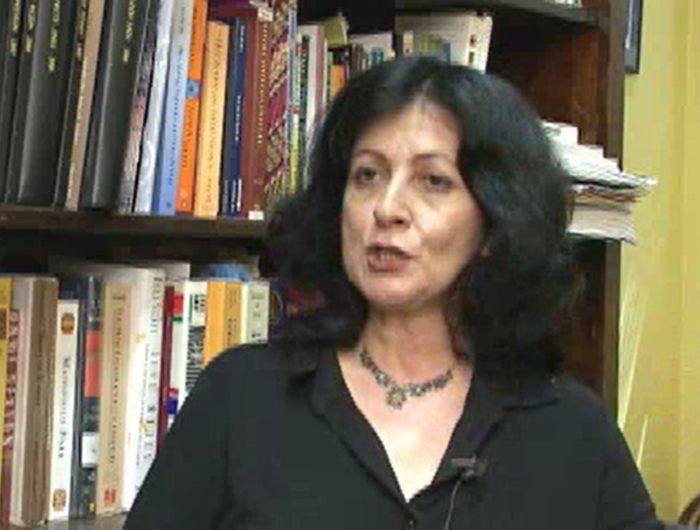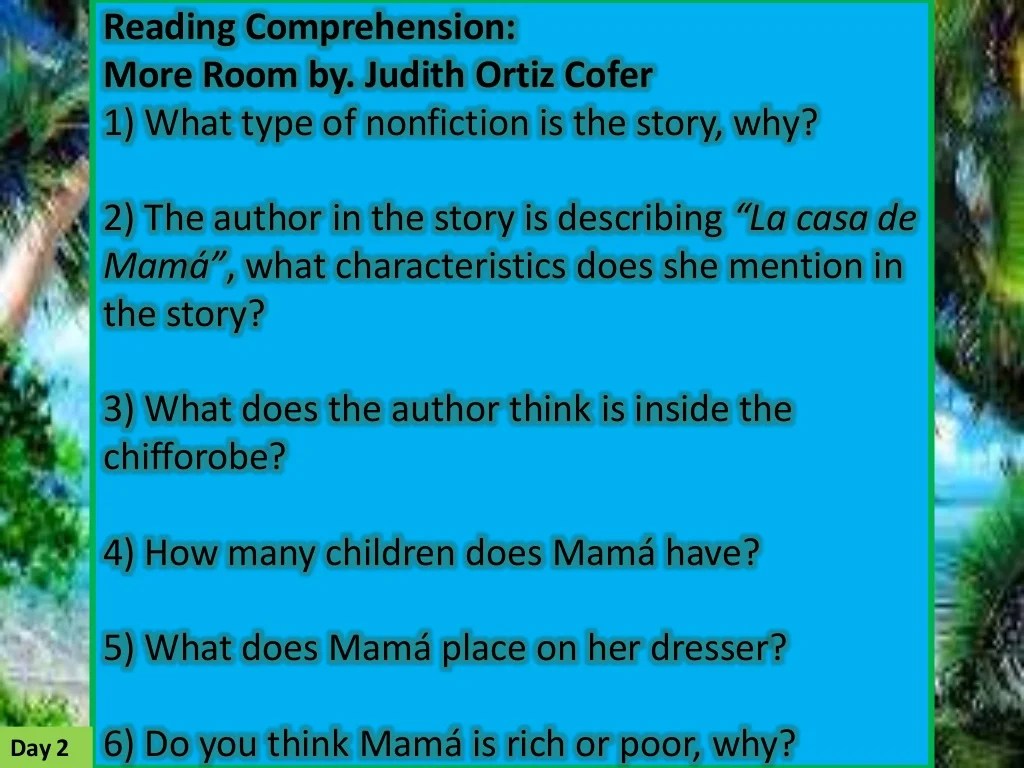More room judith ortiz cofer – In Judith Ortiz Cofer’s captivating narrative, “More Room,” we embark on a journey that explores the complexities of identity and the challenges of finding a sense of belonging in multiple worlds.
The protagonist’s struggle with her Puerto Rican heritage and her desire to assimilate into American culture forms the core of this compelling story, reflecting the intricate tapestry of identity and the search for a place where one truly belongs.
Judith Ortiz Cofer’s “More Room”: More Room Judith Ortiz Cofer
Judith Ortiz Cofer’s “More Room” is a powerful exploration of identity and belonging. Her words resonate with those seeking a deeper understanding of their place in the world. For further exploration of nature and the changing seasons, the seasons 3d gizmo answer key provides valuable insights.
Returning to “More Room,” we find Cofer’s characters grappling with the complexities of identity, reminding us of the ongoing search for meaning and connection in our own lives.
Setting and Symbolism
The house in “More Room” holds deep significance, representing the protagonist’s evolving identity and her search for personal growth. Initially, it confines her, symbolizing the suffocating traditional expectations placed upon her. However, as she gains autonomy, the house transforms into a space of liberation, reflecting her newfound sense of self-discovery.
The “more room” the protagonist seeks is not merely physical but also metaphorical, representing her desire for expanded opportunities and a broader sense of belonging. It symbolizes her yearning to break free from societal constraints and to explore her own unique path, embracing her cultural heritage while forging a distinct identity of her own.
Themes of Identity and Belonging

Judith Ortiz Cofer’s “More Room” delves into the complexities of identity and the challenges of finding a sense of belonging in multiple worlds. The protagonist, Marisol, struggles with her Puerto Rican heritage while simultaneously desiring to assimilate into American culture.
Marisol’s Struggle with Heritage and Desire for Assimilation, More room judith ortiz cofer
- Marisol feels torn between her Puerto Rican roots and her American upbringing.
- She faces prejudice and discrimination from both Puerto Ricans and Americans, leading to a sense of isolation.
- Marisol’s desire to fit in leads her to suppress her cultural identity, resulting in feelings of inauthenticity.
Complexities of Identity and Belonging
The story highlights the challenges of navigating multiple cultures and identities. Marisol’s struggle reflects the complexities of identity, where individuals may feel a sense of belonging and alienation simultaneously.
- The story explores the idea that identity is not static but rather fluid and constantly evolving.
- It suggests that finding a sense of belonging requires embracing both one’s cultural heritage and the complexities of living in a multicultural society.
Character Development and Relationships
Judith Ortiz Cofer’s protagonist in “More Room” undergoes a profound psychological journey as she navigates the challenges of adolescence and immigration. Her experiences shape her character, fostering resilience, independence, and a complex understanding of identity.
The Protagonist’s Psychological Journey
The protagonist’s journey begins with a sense of isolation and displacement. As a young immigrant, she struggles to find her place in a new country and culture. Through her experiences, she learns to embrace her own voice and forge her own path, developing a strong sense of self.
Relationships with Family, Friends, and Community
The protagonist’s relationships play a pivotal role in her growth. Her family provides a sense of stability and support, while her friends offer companionship and a shared sense of belonging. The community, both in her home country and in the United States, shapes her understanding of identity and her place in the world.
Cultural and Social Commentary
Judith Ortiz Cofer’s “More Room” delves into the complexities of Puerto Rican culture and the challenges faced by Puerto Ricans in American society. The story explores themes of identity, belonging, and the social and political issues surrounding immigration, racism, and cultural assimilation.
Portrayal of Puerto Rican Culture
Cofer portrays Puerto Rican culture with warmth and authenticity, showcasing its vibrant traditions, language, and family values. She depicts the characters’ deep connection to their heritage and their struggle to preserve it in a foreign land. The story also highlights the challenges of cultural assimilation, as the characters navigate between two worlds and strive to find their place in both.
Social and Political Issues
The story raises important social and political issues, such as immigration and racism. Cofer portrays the struggles faced by undocumented immigrants, who live in constant fear of deportation and discrimination. She also explores the racial tensions and prejudices that Puerto Ricans encounter in American society.
Through the experiences of her characters, Cofer sheds light on the complexities of immigration and the need for a more just and equitable society.
Literary Techniques and Style

Judith Ortiz Cofer’s “More Room” is a masterfully crafted story that employs a range of literary devices and a distinct writing style to convey its themes and impact the reader. The use of imagery, symbolism, and foreshadowing enriches the narrative, while the author’s lyrical prose and evocative language contribute to the story’s emotional depth and resonance.
Imagery
Cofer paints vivid images throughout the story, immersing the reader in the physical and emotional landscapes of the characters. Descriptions of the cramped apartment, the noisy streets, and the stifling heat evoke a sense of claustrophobia and entrapment that mirrors the protagonist’s inner turmoil.
The recurring image of the “more room” symbolizes the narrator’s longing for freedom, space, and a sense of belonging.
Symbolism
The story is replete with symbolic elements that enhance its meaning and complexity. The apartment represents the constraints and limitations imposed on the narrator by her circumstances and society. The pigeons that fly outside the window symbolize freedom and the possibility of escape.
The radio serves as a conduit for both entertainment and a sense of connection to the outside world.
Foreshadowing
Cofer skillfully uses foreshadowing to create suspense and anticipation. The narrator’s dreams of flying and her fascination with the pigeons hint at her eventual escape from her oppressive environment. The repeated references to the “more room” build a sense of inevitability, suggesting that the narrator’s longing will ultimately be fulfilled.
Writing Style
Cofer’s writing style is characterized by its lyrical prose and evocative language. She employs rich descriptions, evocative metaphors, and rhythmic sentences to create a multi-sensory experience for the reader. The story’s first-person narrative draws the reader into the protagonist’s intimate thoughts and emotions, fostering a deep connection and understanding.
Critical Reception and Legacy

Upon its publication in 1994, “More Room” garnered widespread critical acclaim for its poignant exploration of identity, belonging, and the Hispanic experience in the United States. Critics praised Ortiz Cofer’s lyrical prose, her ability to capture the complexities of human relationships, and her fearless examination of social and cultural issues.
The story’s enduring relevance lies in its timeless themes of identity, belonging, and the search for one’s place in the world. Ortiz Cofer’s exploration of the challenges faced by marginalized communities, particularly Hispanic women, resonates with readers of all backgrounds and continues to inspire and empower.
Contributions to Hispanic Literature
“More Room” has made significant contributions to the field of Hispanic literature. It is considered a seminal work in the development of Latina literature, providing a voice to the experiences and perspectives of Hispanic women in the United States. The story’s exploration of cultural and linguistic identity, as well as its critique of societal norms, has helped to shape the landscape of contemporary Hispanic literature.
Helpful Answers
What is the significance of the house in “More Room”?
The house represents the protagonist’s inner world, reflecting her journey of self-discovery and her search for a place where she can truly belong.
How does the story explore the theme of cultural assimilation?
The protagonist’s struggle to reconcile her Puerto Rican heritage with her desire to assimilate into American culture highlights the complexities of cultural identity and the challenges of finding a sense of belonging in multiple worlds.
What is the protagonist’s psychological journey?
The protagonist undergoes a profound psychological journey as she grapples with her identity, her relationships, and her search for a sense of belonging. Her experiences shape her character and ultimately lead to her growth and self-discovery.